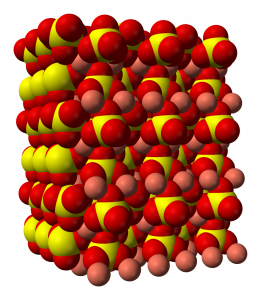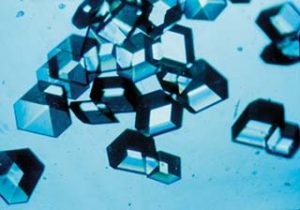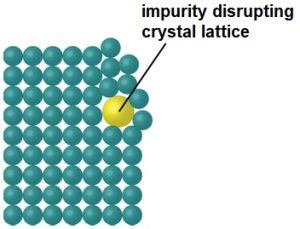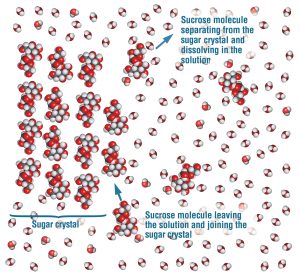12 Recrystallization of Sugar
Purpose
To create crystals of pure sucrose from a sample of brown sugar.
Expected Learning Outcomes
Purify solid compounds through recrystallization.
Accurately and thoroughly describe the appearance of crystals.
Record experimental procedures and observations in the laboratory notebook such that you can use them in the future the next time you have to perform a recrystallization.
Introduction
Most compounds are held together by either ionic or covalent bonds.
- Ionic bonds are formed through the complete transfer of one or more electrons to form a positively charged ion (cation – typically a metal[1] and a negatively charged ion (anion – typically formed from non-metals).
- Covalent bonds are formed by sharing electrons between different atoms, with the central electron being attracted to both nuclei. These are formed typically within nonmetal-only compounds, polyatomic ions, or between metalloids and non-metals.
In this experiment, we will remove the molasses (which gives brown sugar its brown color) and glucose/fructose in brown sugar to create pure sucrose by recrystallizing brown sugar. This is how rock candy is made, although table sugar is usually used to make rock candy instead of brown sugar.
Crystalline Structure of Compounds
Due to the mutual attraction between cations and anions, cations will tend to be completely surrounded by anions, and vice versa. The result is the formation of a stable 3-D crystal lattice structure. The arrangement of cations and anions in a crystal, in turn, contribute to the overall shape of the crystal that is observed. For example, this is the structure of copper(II) sulfate.

Because the shape of a crystal is governed by the arrangement of the ions in the crystalline lattice, this is an important characteristic used in distinguishing between different ionic solids.
But crystals are not exclusive to ionic compounds; other substances such as metallic elements and many covalent compounds form crystals. This is why table salt (an ionic compound) and table sugar (a covalent compound) look essentially the same (small white crystals), but they have such different chemical properties (including taste). One particular example to note of a covalent compound creating crystals is that biomolecules, which in the presence of certain solvents and/or solutions, can form (tiny) crystals. The X-ray diffraction patterns of these crystals can be studied and used to determine the 3-D structure of such biomacromolecules (if you take organic and/or biochemistry at IU East, you will use the data from these types of experiments to learn about the structure and function of different biomolecules).

Regardless of what type of substance is creating the crystal, what’s important for the formation of a crystal is that the different atoms/molecules/ions in the crystal attract each other. In ionic compounds, this attraction is from the electrostatic attraction between oppositely charged ions, while in covalent compounds, this attraction comes from a variety of intermolecular forces, mainly hydrogen bonding (you will learn about intermolecular forces more next semester and in organic chemistry). In a pure crystal, the molecules/ions will be arranged in such a way that maximizes these attractive forces, which will create the repeating structure you see in the crystal lattice structure of copper (II) sulfate above. However, if the crystal isn’t pure, the impurities will disrupt this nice neat packing of the molecules and create a disordered structure around the impurity that means that the rest of the molecules can’t pack together as closely (see figure below[2]) and will thus have weaker attractive forces than in a pure crystal.

To remove such an impurity, we dissolve the crystal in the minimum amount of hot solvent (water in our case) needed to fully dissolve the crystal (i.e. until no more solid crystal is visible) so that the impurity is no longer trapped inside the crystal but instead floating around in solution. The crystal is dissolved because the attractive forces between the solvent molecule (e.g. water) and the crystal molecule (e.g. sucrose) are stronger than the attractive forces between the crystal molecules. This makes the water surround the sucrose molecules so that the sucrose molecules only interact with the water molecules instead of with other sucrose molecules like they do when they are in a crystal (see figure below[3]). This is the definition of “dissolve”, where the molecules in a solid become surrounded by solvent molecules and thus stop being part of a solid.

We need hot solvent because solids are generally more soluble in hot solvents than in cold solvents (e.g. it’s a lot easier to dissolve sugar into hot tea than iced tea). We can then slowly cool the solvent down and the crystal will reform without the impurity. This means that on the macroscale (i.e. what we can observe with our eyes), it often looks like nothing happened during the course of a recrystallization. You will start with a solid crystal in a liquid solvent and you will end with a solid crystal in a liquid solvent. But on the molecular level, you have gone from an impure crystal to a pure crystal.
In our case, because we are removing molasses (which is brown) and forming pure sucrose crystals (which are white), you should see a significant difference between the starting crystal and the ending crystal, but be sure to observe more than just the difference in color between the starting material and the product. We will also be removing small amounts of glucose and fructose from the brown sugar, but because both of these compounds are white, we will need an alternative way to determine if the have actually been removed, which we will learn more about next week.
For a more thorough discussion of the theory behind recrystallization, please see this section of Organic Chemistry Lab Techniques by Lisa Nichols (the textbook used in organic chemistry lab here at IU East).
Describing What You Saw and What You Did
In science, a key part of the practice of science is to record and report what you have done to your peers. For example, a forensic scientist will need to be able to show his/her notes – or his/her tests will be essentially “not done”, and the suspect will be set free!
The standard of notes that will be expected is such that a good student (for example, an MSRC chemistry mentor) is able to repeat your entire procedure without reference to these typed notes. They need to describe (a) what you did (including the amounts of reagents as well as you know it) and (b) what you observed. It need not be in full sentences, but it needs to be intelligible and legible. Crossings-out are okay.
While keeping a good lab notebook is always important, it is particularly important for recrystallization as recrystallization is commonly used in the organic chemistry lab. So if you are planning on taking organic chemistry lab, you will need to do more recrystallizations in the future and it will be extremely helpful to have your own notes on how to do it.
Procedures
You will need to submit your recrystallized product (sucrose) for grading next week, so do NOT dispose of your product when you are done. The quality and yield of crystals will be determined based on the following criteria, with decreasing emphasis down the list (see experiment 5 short report on Canvas for full rubric):
- Purity (5 pts) How pure is your crystal? This will be assessed visually (how white are your crystals?).
- Uniformity (3 pts) How alike do your crystals look? The crystals should have the same color and shape, as the chemical substance is the same.
- Yield (2 pts) How much material did you produce? Note that the yield score is relatively low compared to the other criteria, and you should aim for higher purity and uniformity at the expense of yield.
Note that while large crystals are possible in this experiment, it is not required (nor sufficient) to getting full credit in this experiment, although they do need to be larger than the tiny crystals that you started with for you to get full credit.
Materials Needed
- 150 g (5.3 oz or 1.0 cups) of light brown sugar (granulated sugar will also work, but the difference between before and after recrystallization will be much less obvious)
- a small, clear glass jam jar (any small clear glass container should work, but don’t use plastic as it may or may not stand up to boiling water)
Recrystallization of Brown Sugar
Getting just the right amount of hot water to dissolve the sugar is difficult and requires patience (although doing it too slowly can also be an issue). You might want to do this 2-3 times to make sure at least 1 of them works properly.
- Observe the sugar, making note of the size, shape, and color of the crystals as well as the consistency of these characteristics between crystals (a magnifying glass and a ruler are helpful for this). Take a picture of the starting sugar crystals to include with your lab notebook.
- Put 150 g of sugar in a small jam jar.
- Heat up some water to boiling (1 cup of water should be plenty).
- Use a teaspoon to transfer just enough boiling water to the jam jar to fully dissolve the sugar (meaning that the solution is no longer cloudy – shine a flashlight through the jar to see if you can see if any solid particulates are still floating around).
- Gently stir while adding the water to make sure the sugar dissolves as much as possible (try not to introduce air bubbles).
- You need to transfer the water quickly so that the water does not cool much while you dissolve the sugar, but you also want to add the least amount of water possible, so you don’t want to add the water too quickly. You’ll have to find the balance between adding the water quickly, but not too fast. Stirring constantly will help with this.
- My guess is that you’ll need between 6 and 10 teaspoons of water to fully dissolve the sugar, so I would recommend quickly adding 5 teaspoons, then mix thoroughly, then continue adding 1 teaspoon at a time with stirring until all the sugar is dissolved.
- Record how much water you actually added.
- If you have a a pair of tongs (especially canning tongs) that can grip the jam jar well, putting the jam jar in the boiling water to keep it hot while you add the teaspoons of boiling water to the jam jar will help ensure that you add the minimum volume of water necessary.
- Write down what you observe after adding the first teaspoon of water, what you observe after adding the last teaspoon of water and the exact procedure you used while doing this process.
- Add a few seed crystals of sugar to the sugar solution. In other words, take a few crystals of sugar and add them to the liquid.
- Cover the jam jar with a paper towel secured with a rubber band and let it sit for a week (do not disturb the jam jar over the course of the week, so make sure you put it in an out of the way place).
- Observe the contents of the jam jar every 24 hours for a week (it might be helpful to shine a flashlight through the jam jar).
- At the end of the week, filter the crystals through a coffee filter, rinse them with ice-cold water, let them dry overnight. Record the appearance of the crystals and the filtrate (the liquid that passes through the coffee filter) at each step of this process, especially the size, shape, and color of the crystals as well as the consistency of these characteristics between crystals (a magnifying glass and a ruler are helpful for this).
- Take a picture of your crystals to include with your lab notebook.
Waste Management
DO NOT DISCARD YOUR PRODUCT! Place it in some sort of labeled container to give to your instructor. All other waste can be thrown out in the normal trash (if solid) or rinsed down the drain (if liquid).
- With the important exception of
 , the ammonium ion. ↵
, the ammonium ion. ↵ - https://chem.libretexts.org/Courses/University_of_Kentucky/UK%3A_General_Chemistry/10%3A_Liquids_and_Solids/10.5%3A_The_Solid_State_of_Matter ↵
- https://www.acs.org/education/resources/highschool/chemmatters/past-issues/archive-2014-2015/candymaking.htm ↵
